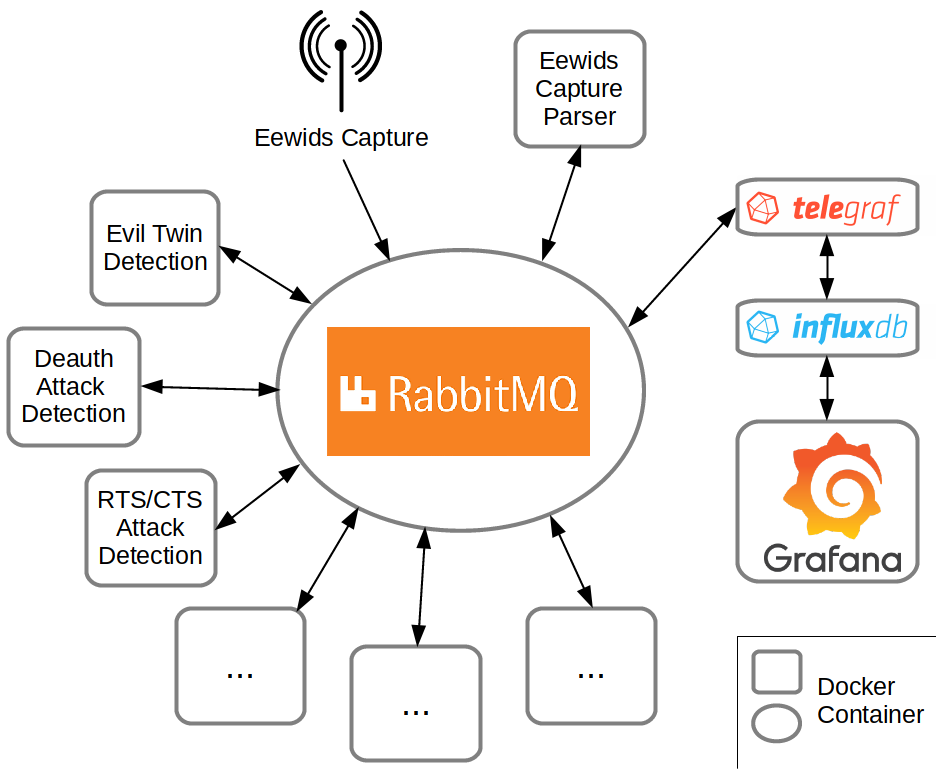This summer I worked on an Easily Expandable Wireless Intrusion Detection System (called Eewids). In this blog post I’d like to present what I’ve done, the current state of the project, the lessons learned and what needs to be done in the future.
Projects repository on GitHub: techge/eewids
What I’ve done
Analyzing existing projects
Before actually starting this project I analyzed existing Free and Open Source Software (FOSS) connected to IEEE 802.11 standard. I achieved this in part by looking through all projects listed on the extensive wifi-arsenal of the GitHub user 0x90 and categorized most of the entries myself.
I realized that there just is no complete ready-to-go WIDS yet, at least regarding FOSS. For me a WIDS should
- detect most of the known Wi-Fi attacks,
- scale easily and thus be able to work within big organizations and
- be easily expandable.
Although there is indeed software on GitHub which can be used to detect Wi-Fi attacks, they are usually specialized on some attacks and/or they are hobby projects which would not fit in setups of bigger environments. Please have a look at the defence-related Wi-Fi tools on the wifi-arsenal list.
A distributed, highly scalable system
Based on a proposal of my mentor Julius Schulz-Zander, I created a framework with a microservice approach. Instead of creating a monolithic solution, Eewids is supposed to consist of different well-known and actively developed software. The central point of Eewids is a message broker. The advantage is an independence between different system components. New detection methods can be added to the system without actually bothering about the capture process, the parsing or even the presentation of the results. Everything leads to the message broker.
RabbitMQ is an awesome choice for such a message broker. It is not only most widely deployed, but it also supports a lot of programming language. No matter if you want to add a detection method using C, python or Java, there already exists a library to easily attach to RabbitMQ, get the captured and parsed data and sent the results back (see RabbitMQs devtools).
The message broker also helps to make the whole system highly distributed and scalable and thus helps to fulfill the requirements to work for bigger organizations as well. Many organizations may already have experiences with RabbitMQ-Clusters.
System components
Eewids consists of:
- a capture tool to get the actual 802.11 data packets
- a parser to transform the information into simple json-formatted data
- a message broker (RabbitMQ)
- detection methods
- a visualization
The project aimed to find a solution for all components.
The capturing should be done by Kismet, which turned out to be a bad idea (see section “Lessons’s learned”). Therefore, a simple capture tool was created, which will be further improved (see section about future work). For parsing the package a parser was created (“eewids-parser”) in part based on the existing project radiotap-python. As kind of proof-of-concept the visualization software Grafana was added (in tandem with InfluxDB). This turned out to be a very good choice and is now integrated as the main visualization in Eewids. Grafana connects easily to various systems, so that other data withing a company may be connected and visualized as well.

Lesson’s learned
At first, I didn’t dare to create a capture tool myself. I thought that this would take a lot of programming experience. Therefore, I have chosen Kismet as a basis for capturing the 802.11 data. Kismet is well-known and very popular. Still, it does not fulfill the above requirements – it is not a full-featured WIDS, it is monolithic and the code proved to be difficult to read/change. I invested a lot of time to integrate Kismet in Eewids, to build docker container (which did not exist before), to read out pcap export from the REST interface etc. In the end I integrated a feature-rich system to only use one function – the capturing. After several crashes of the Kismet server and an analysis of the network performance, I decided to try to create a simple capture tool myself (see this blog post).
It turned out that it is not that difficult to create a simple capture with help of libpcap. Although the capture tool is still very rudimentary it already fulfills the function which Kismet served before. While I still think, that it is always a good idea to have look at existing projects first, I would trust more in my skills next time, to avoid wasting to much time in integrating a system which is not suitable for the project at stake.
What needs to be done in future
While the framework itself is ready and works fine, there is still a lot to do. The capture tool should be further improved as described in this blog post. Getting used to libpcap needed more time than anticipated, so that I was not able to include all features yet.
The parser should get extended depending on upcoming needs. For example, only some element ids are parsed for now. All main 802.11 fields are parsed though. See the projects page for an overview of all parsed data.
More dashboards for Grafana could be added to visualize as much data as possible. Furthermore, some useful notification could be added by default.
Most of all, Eewids should get more actual detection methods in the end. The RogueAP detection that was implemented during the summer is a start, but served mainly as a proof-of-concept and shall be improved. As Eewids is supposed to be easily expandable this last objective should in part get solved by different persons in future.
In the end I am eager to further improve the system even after the end of this Google Summer of Code. I am glad that I had the opportunity to work continuously on this project. Now I am more confident in my skills than before. I’ll surely have less doubts to actually start a project in the future.